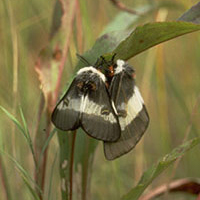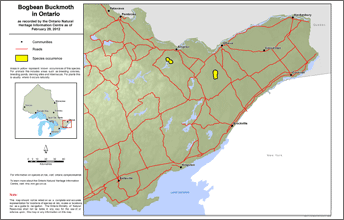Bogbean buckmoth
Scientific name: Hemileuca sp. 1

Cover photo credit: Michael Runtz
Status
Endangered
“Endangered” means the species lives in the wild in Ontario but is facing imminent extinction or extirpation.
Date added to the Species at Risk in Ontario List
September 28, 2010.
Read the Assessment Report
What it looks like
The Bogbean Buckmoth is a medium to large-sized moth with forewings about 26 to 36 millimetres long. The body is largely black with a white collar and both white and orange markings on the thorax and abdomen. Each wing is dark with a thick white band and small dark spot either wholly or mostly within the band.
The larvae, which are mostly black with reddish-orange branched spines along the back, feed primarily on the bogbean plant.
The Bogbean Buckmoth has a one-year life cycle. These moths spend the winter as eggs and emerge as larvae the next spring, becoming adults in mid- to late September.
They are active during the day, typically only in warm, sunny weather. Adults are capable of flying for several kilometres, but rarely leave the fens where they live.
Where it lives
The Bogbean Buckmoth is restricted to open, chalky, low shrub fens containing large amounts of bogbean, an emergent wetland flowering plant.
Where it’s been found in Ontario
In Canada, the Bogbean Buckmoth is restricted to two isolated sites in southeastern Ontario.
This moth also occurs in northeastern New York State in wetlands near Lake Ontario.
View a Larger version of this map (PDF)
What threatens it
Bogbean Buckmoth in Ontario may be threatened by habitat loss and changes including water level fluctuations, land development, insecticide applications and long-term loss of wetland habitat from climate change.
It is also threatened by the effects of invasive plants, especially the European Common Reed and Narrow-leaved Cattail, that are crowding out its preferred food, the bogbean.
Action we are taking
Endangered Species and their general habitat are automatically protected
Recovery strategy
A recovery strategy advises the ministry on ways to ensure healthy numbers of the species return to Ontario.
Read the executive summary (December 7, 2011)
Read the recovery strategy (December 7, 2011)
Government response statement
A government response statement outlines the actions the government intends to take or support to help recover the species.
Read the government response statement (September 7, 2012)
Five-year review of progress
A five-year review of progress made toward protecting and recovering a species is required no later than five years after the government response statement for that species is published.
Read the report on progress towards the protection and recovery of six species at risk, including Bogbean Buckmoth (2017).
Habitat protection
A habitat regulation defines a species' habitat and many describe features (e.g. a creek, cliff, or beach), geographic boundaries or other unique characteristics.
Read the habitat summary (January 1, 2014)
What you can do
Report a sighting
- Report a sighting of an endangered animal or plant to the Natural Heritage Information Centre. Photographs with specific locations or mapping coordinates are always helpful.
Volunteer
- Volunteer with your local nature club or provincial park to participate in surveys or stewardship work focused on species at risk.
Be a good steward
- Private land owners have a very important role to play in species recovery. If you find Bogbean Buckmoth on your land, you may be eligible for stewardship programs that support the protection and recovery of species at risk and their habitats.
- The European Common Reed, an invasive species, is a threat to the Bogbean Buckmoth. To learn what you can do to help reduce the threat of invasive species, visit:
www.ontario.ca/invasivespecies
www.invadingspecies.com
www.ontarioinvasiveplants.ca
www.dfo-mpo.gc.ca/science/enviro/ais-eae/index-eng.htm
Report illegal activity
- Report any illegal activity related to plants and wildlife to
1-877-TIP-SMNR (847-7667) .
Quick facts
- Unlike most buckmoths, which live in drier habitats, the Bogbean Buckmoth depends primarily on wetlands that support the bogbean, its preferred food source.
- The Bogbean Buckmoth spends only a day (for females) or a few days (for males) as an adult.
- The bogbean which this moth eats isn’t a bean at all – the “bean” part of its name refers to the smooth-edged shiny leaves, which are similar in appearance to those of young broad beans.
- Buckmoths are popular with naturalists and entomologists, in part because they are active in the daytime, relatively large, and have striking colouration.
